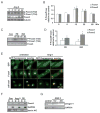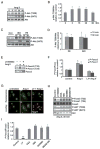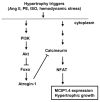Foxo transcription factors blunt cardiac hypertrophy by inhibiting calcineurin signaling
- PMID: 16952979
- PMCID: PMC4118290
- DOI: 10.1161/CIRCULATIONAHA.106.637124
Foxo transcription factors blunt cardiac hypertrophy by inhibiting calcineurin signaling
Abstract
Background: Cellular hypertrophy requires coordinated regulation of progrowth and antigrowth mechanisms. In cultured neonatal cardiomyocytes, Foxo transcription factors trigger an atrophy-related gene program that counters hypertrophic growth. However, downstream molecular events are not yet well defined.
Methods and results: Here, we report that expression of either Foxo1 or Foxo3 in cardiomyocytes attenuates calcineurin phosphatase activity and inhibits agonist-induced hypertrophic growth. Consistent with these results, Foxo proteins decrease calcineurin phosphatase activity and repress both basal and hypertrophic agonist-induced expression of MCIP1.4, a direct downstream target of the calcineurin/NFAT pathway. Furthermore, hearts from Foxo3-null mice exhibit increased MCIP1.4 abundance and a hypertrophic phenotype with normal systolic function at baseline. Together, these results suggest that Foxo proteins repress cardiac growth at least in part through inhibition of the calcineurin/NFAT pathway. Given that hypertrophic growth of the heart occurs in multiple contexts, our findings also suggest that certain hypertrophic signals are capable of overriding the antigrowth program induced by Foxo. Consistent with this, multiple hypertrophic agonists triggered inactivation of Foxo proteins in cardiomyocytes through a mechanism requiring the PI3K/Akt pathway. In addition, both Foxo1 and Foxo3 are phosphorylated and consequently inactivated in hearts undergoing hypertrophic growth induced by hemodynamic stress.
Conclusions: This study suggests that inhibition of the calcineurin/NFAT signaling cascade by Foxo and release of this repressive action by the PI3K/Akt pathway are important mechanisms whereby Foxo factors govern cell growth in the heart.
Figures








Similar articles
-
Atrogin-1 inhibits Akt-dependent cardiac hypertrophy in mice via ubiquitin-dependent coactivation of Forkhead proteins.J Clin Invest. 2007 Nov;117(11):3211-23. doi: 10.1172/JCI31757. J Clin Invest. 2007. PMID: 17965779 Free PMC article.
-
PICOT attenuates cardiac hypertrophy by disrupting calcineurin-NFAT signaling.Circ Res. 2008 Mar 28;102(6):711-9. doi: 10.1161/CIRCRESAHA.107.165985. Epub 2008 Feb 7. Circ Res. 2008. PMID: 18258855
-
FoxO transcription factors activate Akt and attenuate insulin signaling in heart by inhibiting protein phosphatases.Proc Natl Acad Sci U S A. 2007 Dec 18;104(51):20517-22. doi: 10.1073/pnas.0610290104. Epub 2007 Dec 12. Proc Natl Acad Sci U S A. 2007. PMID: 18077353 Free PMC article.
-
Phosphatases at the heart of FoxO metabolic control.Cell Metab. 2008 Feb;7(2):101-3. doi: 10.1016/j.cmet.2008.01.004. Cell Metab. 2008. PMID: 18249169 Review.
-
Calcineurin-NFAT signaling regulates the cardiac hypertrophic response in coordination with the MAPKs.Cardiovasc Res. 2004 Aug 15;63(3):467-75. doi: 10.1016/j.cardiores.2004.01.021. Cardiovasc Res. 2004. PMID: 15276472 Review.
Cited by
-
Identification of the Mtus1 Splice Variant as a Novel Inhibitory Factor Against Cardiac Hypertrophy.J Am Heart Assoc. 2016 Jul 6;5(7):e003521. doi: 10.1161/JAHA.116.003521. J Am Heart Assoc. 2016. PMID: 27385424 Free PMC article.
-
Transcription factor Foxo3a prevents apoptosis by regulating calcium through the apoptosis repressor with caspase recruitment domain.J Biol Chem. 2013 Mar 22;288(12):8491-8504. doi: 10.1074/jbc.M112.442061. Epub 2013 Feb 4. J Biol Chem. 2013. PMID: 23382383 Free PMC article.
-
GSK-3β inhibition protects the rat heart from the lipopolysaccharide-induced inflammation injury via suppressing FOXO3A activity.J Cell Mol Med. 2019 Nov;23(11):7796-7809. doi: 10.1111/jcmm.14656. Epub 2019 Sep 10. J Cell Mol Med. 2019. PMID: 31503410 Free PMC article.
-
The role of ubiquitin ligases in cardiac disease.J Mol Cell Cardiol. 2014 Jun;71:43-53. doi: 10.1016/j.yjmcc.2013.11.008. Epub 2013 Nov 19. J Mol Cell Cardiol. 2014. PMID: 24262338 Free PMC article. Review.
-
Cardiac CIP protein regulates dystrophic cardiomyopathy.Mol Ther. 2022 Feb 2;30(2):898-914. doi: 10.1016/j.ymthe.2021.08.022. Epub 2021 Aug 14. Mol Ther. 2022. PMID: 34400329 Free PMC article.
References
-
- Accili D, Arden KC. FoxOs at the crossroads of cellular metabolism, differentiation, and transformation. Cell. 2004;117:421–426. - PubMed
-
- Tran H, Brunet A, Griffith EC, Greenberg ME. The many forks in FOXO’s road. Sci STKE. 2003:RE5. - PubMed
-
- Stitt TN, Drujan D, Clarke BA, Panaro F, Timofeyva Y, Kline WO, Gonzalez M, Yancopoulos GD, Glass DJ. The IGF-1/PI3K/Akt pathway prevents expression of muscle atrophy-induced ubiquitin ligases by inhibiting FOXO transcription factors. Mol Cell. 2004;14:395–403. - PubMed
-
- Frey N, Katus HA, Olson EN, Hill JA. Hypertrophy of the heart: a new therapeutic target? Circulation. 2004;109:1580–1589. - PubMed
Publication types
MeSH terms
Substances
Grants and funding
LinkOut - more resources
Full Text Sources
Other Literature Sources
Molecular Biology Databases
Research Materials
Miscellaneous

